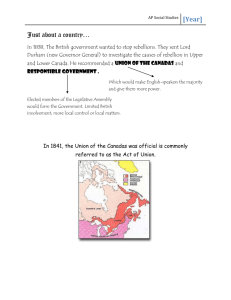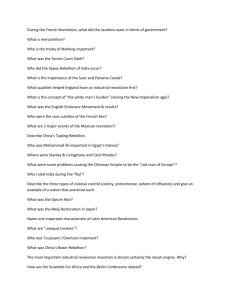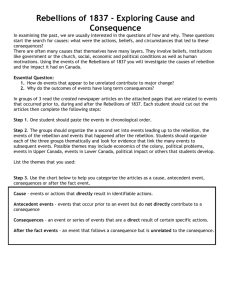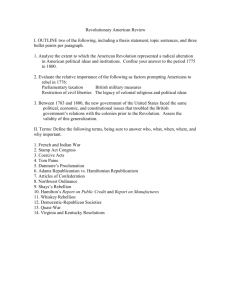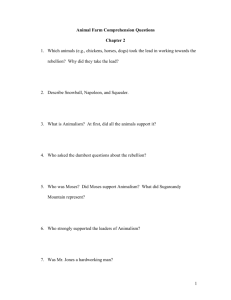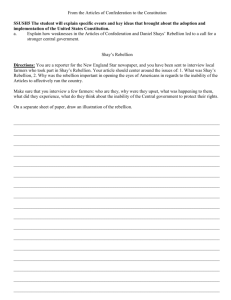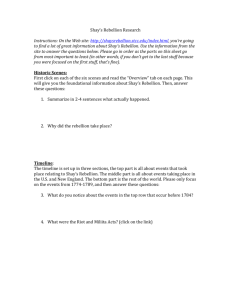A2coursebook.doc - HelpfulHistory.com
advertisement
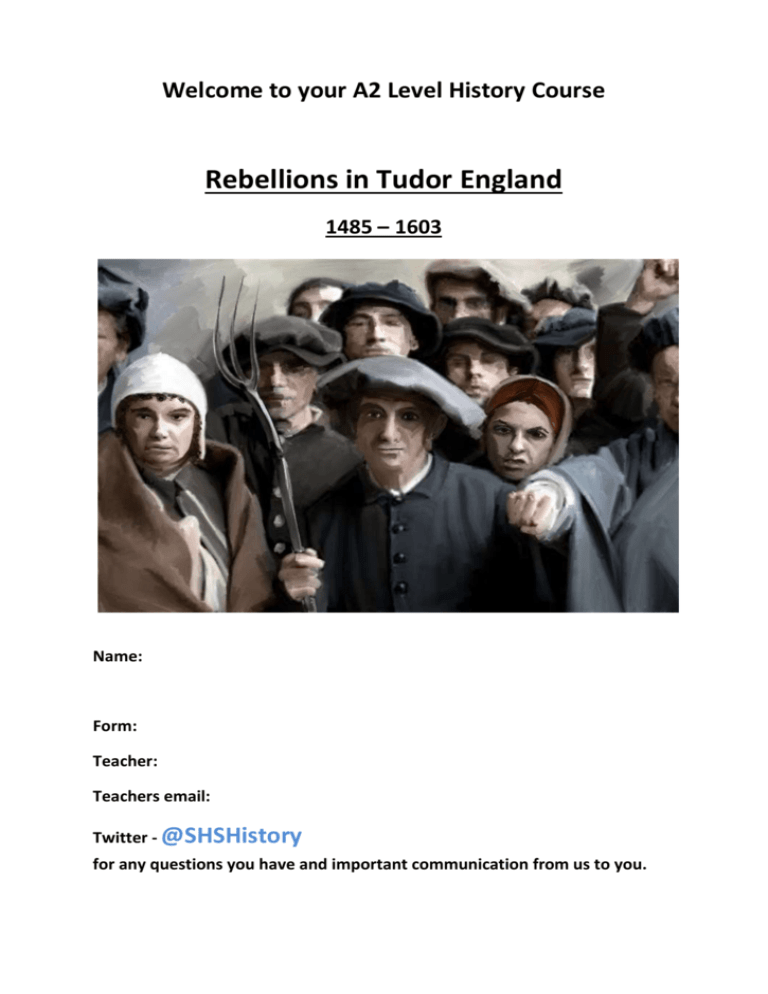
Welcome to your A2 Level History Course Rebellions in Tudor England 1485 – 1603 Name: Form: Teacher: Teachers email: Twitter - @SHSHistory for any questions you have and important communication from us to you. Rebellions in Tudor England 1485-1603 OCR A2 History Unit F966 Course Specification You will begin your A2 course with a brief overview of the Monarchies during the Tudor Age from Henry VII to Henry VIII, Edward VI, Bloody Mary I and finally Elizabeth I. The first key topic to consider is what were the causes of the 19 rebellions in this course? You will identify key themes and elements from each rebellion in a THEMATIC way to see similarities and differences. The main causes range from a political nature, to religion, economic, social and dynastic. You will then look at the nature and frequency of the rebellions over the period to gain a strong understanding of change and continuity. Were there more rebellions in Henry VII’s reign over taxes than Mary’s? Why? What was different in England at each point? Were they led by nobles or peasants? We will then consider the impact this had on the Monarchy and Government, what did they do to counter the rebellion, what did they do as a result of it? Did each Monarch handle things differently or the same? Following on, we will assess how each Monarch maintained stability in their reign. How did they control society? How did they treat the Nobility / Peasants etc… You will be able to identify whether or not they were successful. Whilst going through this course it is VITAL that you approach it from a thematic point of view and don’t just learn about each rebellion, they all cross over and have similarities and differences. You will be expected to identify why a certain situation might arise in 1485 and not in 1553? And that there may not have been much in the way of Religious rebellion in the first 50 years of the Tudor Age, but then under Henry VIII this because the prominent cause of rebellion. What is the difference from AS? – A lot less of a difference from GCSE that is for sure! You have shown the skills necessary for this course by being here. You need to up your independent learning a little bit, making sure you are working independently for about 5 hours a week minimum. You have your course text book which is KEY in knowing – Inside out! – You also have the Forum in Helpfulhistory.com which is a working document but has lots of resources, information and videos to help in your reading. As always, I have lots of books available either proper history books or novels to give you an insight into the period. Assessment will be through class exams, essays and finally in your 1.5 hour exam 2 essay questions worth 60 marks each. You are required to demonstrate a breadth of knowledge at A2 and be able to identify key changes and similarities. You must show your understanding of the WHOLE period not just one event or reign. As you know the Forum on http:/www.helpfulhistory.com is primarily designed for you, and includes sections on Russia too. Use it and suggest to me how I can make it better! Folder organisation is STILL CRUCIAL!! If your folder is organised and you can put your hands on anything at any time, you will give yourself the VERY BEST chance when coming to revise. TRUST ME!!! I would therefore like to recommend the following: A lever-Arch folder to be divided… Admin: A2 Mark scheme etc Course Specifications Content Each rebellion’s 1 page overview Causes (Political / Religion / Economic & Social / Irish) Nature & Frequency Government’s reaction Government’s control and discipline Assessments & Feedback Historiography (Historians ideas and quotes you come across as you study this course) Remember, you are now on an A Level course and you MUST be doing 5 hours INDEPENDENT work a fortnight (AT LEAST) Answer 2 questions each worth 60 marks Mark scheme: Get to grips with this ASAP, if you know what the examiner wants, you can give it to them. IA IB II III IV V VI VII A01a 18-20 16-17 14-15 12-13 10-11 8-9 4-7 0-3 A01b 36-40 32-35 28-31 24-27 20-23 16-19 8-15 0-7 AOs AO1a AO1b Total mark for each question = 60 Recall, select and deploy historical knowledge appropriately, and communicate knowledge and understanding of history in a clear and effective manner. Demonstrate understanding of the past through explanation, analysis and arriving at substantiated judgements of: - key concepts such as causation, consequence, continuity, change and significance within an historical context; - the relationships between key features and characteristics of the periods studied Excellent understanding of key concepts (eg continuity and change) relevant to analysis in their historical context Excellent synthesis and synoptic assessment Answer is consistently and relevantly analytical with developed explanations and supported judgements May make unexpected but substantiated connections over the whole period 36-40 Very good level of understanding of key concepts (eg continuity and change) in their historical context. Answer is consistently focused on the question set Very good level of explanation/analysis, and provides supported judgements. Very good synthesis and synoptic assessment of the whole period 32-35 Good level of understanding of key concepts (eg continuity and change) in their historical context Good explanation/analysis but overall judgements may be uneven Answer is focused on the issues in the question set Good synthesis and assessment of developments over most of the period 28-31 Level IA Uses a wide range of accurate and relevant evidence Accurate and confident use of appropriate historical terminology Answer is clearly structured and coherent; communicates accurately and legibly. 18-20 Level IB Uses accurate and relevant evidence Accurate use of a range of appropriate historical terminology Answer is clearly structured and mostly coherent; communicates accurately and legibly 16-17 Level II Uses mostly accurate and relevant evidence Generally accurate use of historical terminology Answer is structured and mostly coherent; writing is legible and communication is generally clear 16-17 Level III Uses relevant evidence but there may be some inaccuracy Answer includes relevant historical terminology but this may not be extensive or always accurately used Most of the answer is structured and coherent; writing is legible and communication is generally clear 12-13 Level IV There is deployment of relevant knowledge but level/accuracy will vary. Some unclear and/or underdeveloped and/or disorganised sections Mostly satisfactory level of communication 10-11 Level V General and basic historical knowledge but also some irrelevant and inaccurate material Often unclear and disorganised sections Adequate level of communication but some weak prose passages 8-9 Level VI Level VII Use of relevant evidence will be limited; there will be much irrelevance and inaccuracy Answers may have little organisation or structure Weak use of English and poor organisation 4-7 Little relevant or accurate knowledge Very fragmentary and disorganised response Very poor use of English and some incoherence Shows a sound understanding of key concepts, especially continuity and change, in their historical context Most of the answer is focused on the question set Answers may be a mixture of analysis and explanation but also description and narrative, but there may also be some uneven overall judgements; OR answers may provide more consistent analysis but the quality will be uneven and its support often general or thin Answer assesses relevant factors but provides only a limited synthesis of developments over most of the period 24-27 Satisfactory understanding of key concepts (eg continuity and change) in their historical context Satisfactory focus on the question set Answer may be largely descriptive/narratives of events, and links between this and analytical comments will typically be weak or unexplained Makes limited synoptic judgements about developments over only part of the period 20-23 General understanding of key concepts (eg continuity and change) in their historical context Some understanding of the question but answers may focus on the topic and not address the question set OR provides an answer based on generalisation Attempts an explanation but often general coupled with assertion, description/narrative Very little synthesis or analysis and only part(s) of the period will be covered 16-19 Very little understanding of key concepts (eg continuity and change) in their historical context Limited perhaps brief explanation Mainly assertion, description/narrative Some understanding of the topic but not the question’s requirements 8-15 Weak understanding of key concepts (eg continuity and change) in their historical context No explanation Assertion, description/narrative predominate Weak understanding of the topic or of the question’s requirements 0-7 These are quite complicated, but once you know what you need to do for each level it will become more useable. Use this as a checklist for your essays to see if you have done what you needed to for a specific level. You must satisfy both AO’s (Assessment Objectives) basically what it is assessing, you can see the description of the AO’s at the top of this mark scheme in the grey box. In your exam you need to answer 2 questions, both with 60 marks each. Roughly the grade boundaries will be 24 / 60 = E 30 / 60 = D 37 / 60 = C 42 / 60 = B 47 / 60 = A This is what we’ll use when marking your assessments and essays. You MUST be aware of what the examiner is looking for from the above markscheme. Essay check sheet. Please use this in conjunction with your OCR Mark scheme sheet to make sure you are meeting all requirements. Start: Have you planned your answer? Intro: Does your introduction list what you are going to discuss? Have you stated your argument? Paragraphs: Have you written in clear structured and organised paragraphs? Does each paragraph have a clear point? Have you used good evidence to back up your point? Have you explained? Have you referred back the question when concluding each paragraph? Do your paragraphs link? Conclusion: Have you answered THE QUESTION? Does your conclusion correspond with your introduction? Have you incorporated a decision (more important, less important, etc) Have you summarised your overall argument? A Level extra’s: Have you included your own reading? Have you considered change and continuity (where applicable) Have you shown context of whole period (where applicable) Have you used / considered historian’s opinions? Have you analysed other opinions? Is your grammar and spelling correct? As always, if you are stuck, or need guidance, please pop in and speak to your teachers, please don’t leave it until the day its due as that may result in a Fail. Tudor Rebellions 1485 – 1603 Topic Checklist All Rebellions I know each Monarch and when they reigned I have completed and understand each rebellions overview sheet I know all rebellions off by heart and whose reign they were in Topic 1: Causes I know all rebellions that are caused by Political factors (Dynastic, Succession, Evil Councillors, Factions, Reactions to Gov’t policy I know all rebellions that are caused by Religious issues. (Reaction to reformation from Catholics and Protestants) I know which rebellions were caused by Social and Economic factors. (Taxation, enclosures, famine, inflation, landlord/tenant relations. I can identify Change and Continuity of causes across the period Topic 2: Nature and Frequency of rebellion I know the objectives, duration and location of each rebellion I know which rebellion has a Dynastic, Anti-Gov’t policy or Irish nature Topic 3: How did the Government deal with the rebellions I know how Henry VII dealt with his rebellions I know how Henry VIII dealt with his rebellions I know how Edward VI (Somerset / Northumberland) dealt with his rebellions I know how Mary dealt with his rebellions I know how Elizabeth dealt with his rebellions I can identify key ‘Change & Continuity’ throughout the period Topic 4: How did each Monarch maintain political stability? Institutional developments Change and Continuity of each Monarchs policies Assessments / Mark scheme I understand the Mark scheme’s requirements for my desired grade I have read all of the essays and noted feedback from text book I have acted on and fixed the guidance on my class essays Key events / Themes Time line – LEARN THESE EVENTS AS A MINIMUM!! 1485: Accession of Henry VII 1486: Henry VII married Elizabeth of York; Lord Lovel’s revolt; rising by the Staffords 1486-7: Simnel’s rebellion (Pretending to be Earl of Warwick, Richard III’s nephew; supported in Ireland by Kildare 1489: Anti-tax riots in Yorkshire 1491-7: Warbeck’s rebellion (pretending to be Richard (younger Prince in the Tower); supported by Kildare 1495: ‘de facto’ Act; Execution of Sir William Stanley 1497: The Cornish rebellion 1499: Executions of Warwick and Warbeck 1504: Statute against retaining; purge of the Suffolk family and its associates (Suffolk himself surrendered by Burgundy 1506 and executed 1513) 1509: Accession of Henry VIII 1513-25: Various localised anti-tax riots 1521: Execution of Buckingham 1525: Disturbances caused by the Amicable Grant 1528: Widespread unrest across East Anglia 1534: Act of Supremacy passed; Kildare rebellion 1536-7: Pilgrimage of Grace (over 200 executed); Council of the North reorganised 1538: Executions of surviving Yorkists 1539: Act of Six Articles passed 1540-6: Increase in frequency and violence of hedge-breaking riots 1542-3: Wars with Scotland and France began 1547: Accession of Edward VI; heresy Laws repealed; Chantries Act passed 1549: The Western rebellion; Kett’s rebellion (over 50 executed) 1553: Northumberland’s abortive coup and Mary’s accession 1554: Wyatt’s rebellion and other risings (over 100 executed) 1555: Burning of heretics begins 1556: Plantations started in King’s County and Queen’s County 1558: Accession of Elizabeth I; Shane O’Neill began rebellion in Ulster (murdered by the MacDonalds in 1567) 1568: Mary Queen of Scots fled to England (executed 1587) 1569-70: Rising of the Northern Earls (over 400 executed); Council of the North strengthened 1569-73: rebellion in Munster by Fitzmaurice Fitzgerald 1570: Excommunication of Elizabeth I by Pope Pius V 1571: Second Treasons Act 1572: Colonisations began in Ireland 1579-83: Desmond rebellion in Ulster, Leinster, Connaught and Munster 1595: Hugh O’Neill, Earl of Tyrone began national uprising in Ireland 1596: Various localised anti-enclosure riots 1599: Essex sent to Ireland, returned and arrested 1601: Essex’s rebellion; Poor Law Act (revising 1597 Poor Law Act) 1603: O’Neill surrendered Era Main Developments 1485-1509 (Henry VII) 1509-47 (Henry VIII) 1486 Henry VII’s marriage to Elizabeth of York 1486-7 disaffected Yorkists and claimants 1489 tax protests in Yorkshire 1497 tax demands for Scottish war 1497 Cornish support for pretender 1499 execution of Warbeck and Earl of Warwick 1520s financial cost of French war 1534 Kildare detained in the Tower 1530s as Head of the Church, Henry closed the monasteries 1541 Henry assumed direct rule in Ireland Outcome 2 legitimate sons and stability Lovell’s rebellion Simnel rebellion Murder of Northumberland Cornish rebellion Warbeck rebellion Henry VII was politically more secure Amicable Grant protests and other localised tax riots ‘Silken Thomas’ rebellion Pilgrimage of Grace (1536-7); Council of the North reorganised Henry became ‘King of Ireland’ 1547-53 (Edward VI) 1553-58 (Mary I) 1558-1603 (Elizabeth I) 1540s cost of war with France and Scotland caused severe social and economic distress Somerset’s Protestant reforms 1549-56 poor harvests and high grain prices 1553 political coup on behalf of Lady Jane Grey 1554 Mary planned to marry Philip of Spain 1556 Clan feuding and civil revolts 1558 Shane O’Neill not appointed the Earl of Tyrone 1560s Protestant Church Settlement 1568 Arrival of Mary Queen of Scots and political disillusionment 1567 Elizabeth imprisoned Desmond 1579 Fitzgerald returned from Rome to Dublin 1585 war with Spain 1588 Spanish Armada 1593 Hugh O’Neill elected Earl of Tyrone but keen to rule Ulster and expel English from Ireland 1596 anti-enclosure riots 1601 prominence of political court factions (Essex / R.Cecil) Kett’s rebellion in Norfolk Western rebellion and other risings Northumberland’s revolt (Devise) Wyatt’s rebellion Plantations began in King’s County and Queen’s County Shane murdered halfbrother and began a rebellion (1558-67) Northern Earls revolt (1569-70) which led to the strengthening of the Council of the North Fitzgerald, cousin of Desmond, began uprising in Munster (1569-73) Fitzgerald and Desmond began rebellion (1579-83) High tax demands and widespread social distress Tyrone began national uprising (1595-1603) that saw Spanish troops land at Kinsale (1601) Oxfordshire rebellion Essex Rebellion “Don’t forget what you ALREADY know from your study of Elizabeth I at AS Level. Reuse some of your notes if you want, particularly for Northern Rebellion, Essex Rebellion, Famine and economy etc…” Rebellion: Cause(s): Location(s): Date: Monarch: Durations: Key People: Nature: This is an example of what I recommend you do for EVERY rebellion, key headings as a minimum. Objectives (Did these develop / change?): Leadership: Size: Support: Frequency: Response of Government: Some of this information won’t necessarily be available until we advance through the course, but you can still read ahead. I suggest you have 19 of these pages. Effect on society / Government: Success / Failure: NB: I have electronic versions if you require one. Or they will be on Helpful History. Context of period: eg Henry VII – Wars of the Roses, Factions York Vs Lancaster, succession etc… eg Famine, Unemployment high, War (taxes), Religion issues rife, minority government etc… 1485-1509: Succession / Taxes 1509-1536: Taxes 1536-1558: Religion / Reformation 1558-1603: Succession (cloak of religion), Government policies Is this rebellion different to others? Is this rebellion the same as others? If Multi causal, rank importance of each cause with an explanation: NB: Examiners like religion being a “cloak” of real cause / objective Maintaining political stability Monarchy: Propaganda: The Church: Local Clergy: Parliament Royal Councils: (Privy, Welsh, North) Law: Royal Commissions & JP’s Sheriffs: Nobility Religion Economic Social Ireland Change 1485-1603 Continuity 1485-1603 Assessments and Feedback – Please read and act on advice and feedback. NB: Assessments could be essay, exam or presentation. Assessment Grade / Score Feedback Historiography – fill this out as you go through this course Historian What have they said? Positive / Negative? Tudor England Key Terms: As well as these, please compile your own glossary from pg 145 in your text book. Regency Council: The body of sixteen set up under the terms of Henry VIII’s will to exercise power during Edward VI’s minority until he turned 18. Protectorate: Somerset created himself the king’s protector. In this context, Protectorate is a term that covers all aspects of his government. Heresy: The process of rejecting the established rules (doctrines) of the Church. Punishment was burning. The Heresy law was repealed in Edward’s reign, to be reinstated under Mary I. Religion Key Terms: Iconoclasm: The destruction of images within Churches. Injunctions: Orders issues for the implementation of Church policy either by the Crown exercising royal supremacy or individual Bishops. Chantries: Chapels set aside for the singing of masses for dead souls in purgatory. Purgatory: Traditional Catholic beliefs of the place dead souls went to be judged before entering heaven. The Church of England officially rejected this belief and so made the Chantries redundant. Transubstantiation: This had been Catholic doctrine since the 13th Century proclaiming the bread and wine were transformed into the actual body and blood of Christ during communion. Elevation of the Host: Since the 13th Century the Host (bread) was raised by the priest and shown to the congregation. Communion in Both Kinds: Before the reformation, priests took Communion in Both Kinds – that is, both consecrated bread and consecrated wine. Normal people took just the bread. This practice was challenged by Martin Luther saying normal people should receive both too. Common phrases and Common spelling mistakes The following terms are often misspelt / misunderstood Elizabeth Please remember that she has a capital letter. parliament Please remember that it has an “a” in the middle. government Please remember that it has an “n” in the middle. Royal Prerogative Means the power of the Monarchy (eg to determine policy in Matters of State). Parliamentary Privilege The freedoms of the Houses of Parliament (particularly over free speech) Prestige This means the reputation and image. How, for example, the monarchy is regarded. Monopolies The sole right to sell a particular good or service. Effective How good something is at achieving its aims. Faction Fluid alliances around powerful men seeking patronage Above all, write in paragraphs (about five to seven is normal) and ensure that you directly answer the question frequently, Where possible refer to the question in EVERY paragraph to be safe! Your paragraphs should ALWAYS PEE... P= Point (your idea). E= Explain (develop your analysis) E= Evidence (you must use specific and detailed evidence) Introduction This should be short and sweet, just a few lines to outline what you will include in your essay. Main body- Here’s what the examiner wants to find out: Do you know your history, and do you know it precisely enough? DETAILS count! This is a persistent complaint from the Exam board. If needed have you shown knowledge of the historical debate? Do you know how to write a structured piece of writing - i.e. Introduction/Paragraphs/Conclusion BALANCE- Do you show both points of view? EXPLAINS- points must be explained in detail. This means not producing a shopping list! You must expand your point. Look at this example: Example 1.) ‘The Red Army won because of the leadership of Trotsky.’ Example 2.) ‘The Red Army won because of the leadership of Trotsky. He disciplined the army.’ Example 3.) ‘The Red Army won because of the leadership of Trotsky. He disciplined the army. This was important because many of the Red army’s recruits were desperately poor and militarily inexperienced workers who merely joined up to be fed and clothed. This initially made them a weaker army who were liable to desert. Trotsky re-introduced the death penalty which helped to ensure a transformation from a rag bag army to a professional fighting force .It was a successful move as desertion in the Red army decreased whilst white generals still struggled to get respect from their troops. LINKS the points together to answer the question. This ensures a flow to your essay, and shows how you see how one factor can influence another. This is joined-up thinking. Conclusion- How to finish your essay – ANSWER THE QUESTION. This part is very important, and if you’re running out of time you must get to this point sharpish! This part shows your summary and answers the question directly. DON’T just repeat what you have said before, DON’T introduce new ideas, you must lift your argument to a higher level, here you show where significance lays/links between points and your opinion which of course flows beautifully from your main body. Of course you must support everything you say, it’s not the place to rant and rave aimlessly. “Having discussed… (summarise your points) It is clear that Elizabeth had total control of her Parliament by rarely giving into their demands, the only time she did was as discussed … the Monopolies crisis in 1601.” REPORT ON RECENT A LEVEL EXAMS What the examiners say: At the very top levels, candidates will be making judgements in every paragraph about importance or success etc. These judgements should not be ‘bolted on’ to the end of a paragraph, but explained throughout the essay. What we say: Make sure that you support your judgements with EXAMPLES or they just become assertions with no weight. The same applies to LINKING. Don’t just assert that there is a link – give evidence to show that the link exists and explain the impact of this on the question. Remember: Although aiming for judgement throughout is important for higher levels, it is also important to include a good, full conclusion which reaches an overall judgement and focuses on the demands of the question. The examiner noted that some ‘average responses’ were taken into the next level by a well-developed conclusion that reached a judgement. What the examiners say: Candidates who are hoping to score at the higher end of the mark range should pay particular attention to key words and phrases in the question and ensure that they focus their answer on them. When candidates are asked about ‘effective’ the examiner does not want an answer that focuses on ‘successful’. Similarly, ‘assess’ doesn’t mean list, it requires you to compare, link and explain the relative importance of the issues that you consider. What we say: Use your introduction to define any key words and phrases. It may help to indicate criteria to judge whether the concepts in the question have been met – e.g. what will ‘effectiveness’ look like? Make sure you pay attention to DATES in the question too so that you don’t cover issues outside of the period in question. What the examiners say: Marks are not just awarded for knowledge, but for the USE of knowledge. Very often a few, well-chosen examples are better than an exhaustive list of all the facts about a topic. What we say: Make sure that you use RELEVANT knowledge rather than writing down everything that you know. Be selective! This will help with timing too.
